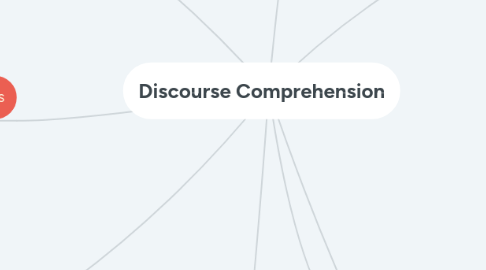
1. Psychological mechanisms in theories of comprehension
1.1. cognitive components
1.1.1. explanations
1.1.2. repetition & automaticity
1.1.3. resonance
1.1.4. discourse focus
1.1.4.1. consciousness
1.1.4.2. focal attention
1.1.5. activation, inhabitation & suppresion of nodes
1.1.6. memory stores
1.1.6.1. STM
1.1.6.1.1. most recent clause
1.1.6.2. WM
1.1.6.2.1. holds two sentences
1.1.6.2.2. recycling of important information
1.1.6.3. LTM
1.1.7. Spreading activation of nodes in knowledge networks
1.1.8. Reader goals
1.1.9. knowledge structures
1.1.10. cnvergence and constraint satisfaction
2. Referring expressions
2.1. nouns
2.2. deitic
2.2.1. world
2.3. cataphonic
2.3.1. future textnodes
2.4. anaphonic
2.4.1. previously mentioned
2.5. rules
2.5.1. the indefinite determiner
2.5.2. richly specified noun
2.5.3. descriptive set of adjectives and prepositional phrases
2.6. noun-phrases
2.7. pronouns
2.8. Structure building framework
2.8.1. lay a foundation
2.8.1.1. mapping on information
2.8.1.2. initiate a new substructure
2.8.1.3. new foundation
3. Pragmatics and agents of communication
3.1. character agents
3.1.1. novels/short stories
3.1.2. direct speech
3.2. pragmatic principles
3.2.1. make true claims under consideration
3.2.2. use discours cues
3.2.2.1. signal important information
3.2.2.2. distinguish 'given' vs 'new' information
3.2.3. make true claims under consideration
3.2.4. monitor common ground and mutual knowledge
3.2.5. the incoming sentence should be relevant
3.2.6. the order of mentioning events should correspond to the chronological order of events in the situation model
3.3. pragmatic agents
3.3.1. communicate exchange
3.4. inquisitive strategy
3.4.1. more elaborate representation
3.5. multiple agents
3.5.1. speakers
3.5.2. perceiving
3.5.3. knowing
3.5.4. wanting
3.5.5. acting
3.5.6. experience emotions
4. Connecting statements in discourse
4.1. global coherence
4.2. local coherence
4.3. dimension of continuity
4.3.1. argument overlap
4.3.1.1. text coherence
4.4. surface code
4.4.1. critical cues
4.5. event indexing model
4.5.1. spatial discontinuity
4.5.1.1. transitional phrases
4.5.2. temporal discontinuity
4.5.2.1. transitional phrases
4.5.3. intentional discontinuity
4.5.4. casual discontinuity
4.5.5. protagonist discontinuity
4.5.6. intentional discontinuity
5. Levels of discourse representation
5.1. Surface code
5.1.1. Exact wording
5.1.2. Syntax of Clauses
5.2. Communication
5.2.1. Pragmatic communicative context
5.2.1.1. Defamiliarization
5.3. Textgenre
5.3.1. narration
5.3.2. exposition
5.3.3. Description
5.3.4. persuasion
5.3.5. jokes
5.4. Literary studies
5.5. Situation model
5.5.1. content of microworld
5.5.1.1. interaction between text & background world knowledge
5.6. Textbase
5.6.1. Inferences
5.6.1.1. establish local text coherence
5.6.2. Explicit text propositions
5.6.2.1. meaning
5.6.3. structured set of propositions
5.6.3.1. contains a predicate
5.6.3.2. state
5.6.3.3. event
5.6.3.4. action
5.6.3.5. truth value (?)
5.6.3.6. contains one or more arguments
5.6.3.6.1. agent
5.6.3.6.2. patient
5.6.3.6.3. object
5.6.3.6.4. location
6. Cognitive models and architects
6.1. models of textcomprehension
6.1.1. representations
6.1.2. processes
6.1.3. interactive mechanisms
6.2. fine-grained models
6.2.1. creation
6.2.2. activitation
6.2.3. inhibition
6.2.4. suppresion
6.3. CAPS/READER
6.3.1. creating, updating and removing nods in WM & LTM
6.4. Construction-integration model
6.4.1. neural network of cognition
7. Separation and interaction levels
7.1. modularity theory
7.1.1. syntax reigns early
7.2. interactivity theory
7.2.1. semantic & discourse context
7.3. sentence recognitions judgements
7.3.1. original sentence verbatim
7.3.2. a paraphrase of the original sentence
7.3.3. a plausible interference
7.3.4. a false statement
7.4. discourse affect word sense activation
8. Knowledge-based inferences
8.1. character traits
8.2. attitudes of the writer
8.3. characters' knowledge beliefs
8.4. character emotions
8.5. the referents of nouns & pronouns
8.6. global theme
8.7. causes of events
8.8. special relationships among entities
8.9. consequenses of events and actions
8.10. properties of objects
8.11. spacial context
8.12. appropriate emotional reaction of reader
8.13. goals and plans subordinated goal
8.14. five classes of interferences
8.14.1. subordinate goal
8.14.2. subordinate goal or action
8.14.3. casual antecedent
8.14.4. casual consequence
8.14.5. static property
8.15. constructionist theory
8.15.1. comprehension goals
8.15.2. explain
8.15.2.1. distinctive prediictions
8.15.3. establish coherence
